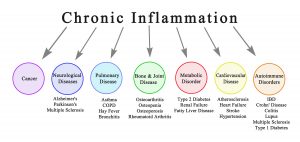Published on August 18, 2023
Excess omega-6 intake can contribute to chronic inflammation or an Omega-3 Index that does not increase as expected – here’s what you can do to address both
Key Points
- According to experts, the optimal, anti-inflammatory AA:EPA Ratio is between 1.5 and 3; unfortunately, the average AA:EPA ratio in the US is greater than 20
- Many individuals rely on taking omega-3 supplements to increase their Omega-3 Index and improve their overall omega status, however, some have experienced a lack of response in the Omega-3 Index even with increased intake from supplements and food; this can be due to several factors, including the type of omega-3 supplement you are taking, as well as getting too many omega-6 fatty acids in the diet
- Reducing intake of both AA and LA (much of which is converted into AA) is necessary for an optimal anti-inflammatory effect. It is important to note that the conversion of LA into AA is increased when insulin levels are elevated, due either to regular intake of high glycemic foods or due to insulin resistance – a reason maintaining healthy blood sugar levels is also important to controlling inflammation.
 In our previous post, we reviewed how chronic, low-level inflammation (the kind that is not typically associated with pain and can remain silent for years) has been linked to a number of chronic diseases, ranging from cardiovascular disease to diabetes, cancer, dementia, autoimmune disease, mental health disorders, and more. The higher the inflammation levels in the body, the higher the risk of developing these diseases.
In our previous post, we reviewed how chronic, low-level inflammation (the kind that is not typically associated with pain and can remain silent for years) has been linked to a number of chronic diseases, ranging from cardiovascular disease to diabetes, cancer, dementia, autoimmune disease, mental health disorders, and more. The higher the inflammation levels in the body, the higher the risk of developing these diseases.
Using the AA:EPA Ratio to Gauge Inflammation Levels
Several tests, such as those included in the Inflammation Panel test kit offered by GrassrootsHealth, can help an individual identify the amount of inflammation hiding within their body. One of the measurements included in the Inflammation Panel is the AA:EPA Ratio, which shows you your ratio of arachidonic acid (AA), considered the main pro-inflammatory omega-6 fatty acid (found in foods such as vegetable oils, butter, poultry and red meat), to eicosapentaenoic acid (EPA), a major anti-inflammatory omega-3 fatty acid (found primarily in fatty fish). This ratio may serve as an indication of the amount of inflammation in the body over the last 3-4 months before testing.
AA:EPA Ratio can also tell you if you have enough of the necessary building blocks for the complete resolution of inflammation, as described in a paper by B Sears and AK Saha. According to the authors and other experts, the optimal, anti-inflammatory AA:EPA Ratio is between 1.5 and 3. Unfortunately, the average AA:EPA ratio in the US is greater than 20.
To achieve the optimal, anti-inflammatory AA:EPA Ratio, an intake of 2.5 to 4 g per day of supplemental omega-3s may be necessary for most individuals, with a more accurate supplemental intake determined based on the measurement of the AA:EPA ratio.
The Omega-6:Omega-3 Ratio – Another Measurement to Keep Your Eye On
 The Omega-6:Omega-3 Ratio is also included in the Inflammation Panel. The omega-6 to omega-3 ratio is calculated by dividing the sum of seven different omega-6 fatty acids by the sum of four different omega-3 fatty acids. This ratio is a more general measurement of overall status of omega fatty acids in the body and can be used as another measure for inflammation.
The Omega-6:Omega-3 Ratio is also included in the Inflammation Panel. The omega-6 to omega-3 ratio is calculated by dividing the sum of seven different omega-6 fatty acids by the sum of four different omega-3 fatty acids. This ratio is a more general measurement of overall status of omega fatty acids in the body and can be used as another measure for inflammation.
The target range for the Omega-6:Omega-3 Ratio is considered to be 3:1 to 5:1, although evidence suggests that lower ratios are better for health. While a lower ratio of each correlates with a higher Omega-3 Index, it is possible to have an Omega-3 Index within a healthy range (recommended at 8% or greater) but have one or both ratios higher than desirable. In this case, omega-6 intake may need to be addressed.
Taking Omega-3s Without Seeing an Improvement in Your Omega-3 Index? It Could be Due to Getting Too Many Omega-6s
Many individuals rely on taking omega-3 supplements to increase their Omega-3 Index and improve their overall omega status, however, some have experienced a lack of response in the Omega-3 Index even with increased intake from supplements and food. While this may be due to several factors, including the type of omega-3 supplement you are taking, it could also be due to getting too many omega-6 fatty acids in the diet.
Knowing your ratios can help you take more specific steps to achieve an ideal ratio status, mainly by increasing omega-3 intake with supplements and food (fatty fish) while also decreasing omega-6 intake. Doing this may not only improve your AA:EPA and Omega-6:Omega-3 Ratios, but it will likely also improve your Omega-3 Index.
Decreasing Your Intake of Omega-6s Can Also Result in a Greater Anti-Inflammatory Effect
An anti-inflammatory diet should consist of a reduced intake of omega-6 and saturated fatty acids, as well as an increase in omega-3 fatty acids (especially DHA and EPA). In fact, less AA is generated when there are higher levels of EPA in the diet, making increased omega-3 consumption particularly important.
An anti-inflammatory diet should also result in lowering the amount of AA in the blood cell membranes, as having too much AA can amplify the initial inflammatory response and make it difficult to resolve inflammation. Reducing intake of both AA and linoleic acid (much of which is converted into AA) is necessary for an optimal anti-inflammatory effect. It is important to note that the conversion of LA into AA is increased when insulin levels are elevated, due either to regular intake of high glycemic foods or due to insulin resistance – a reason maintaining healthy blood sugar levels is also important to controlling inflammation.
The overall balance of omega-6 to omega-3 fatty acids in the diet should be no greater than 2:1; the lower the ratio the better to help lower inflammation levels. Other suggestions for reducing diet-induced inflammation, by B Sears and AK Saha, include
- calorie restriction with adequate protein coupled with a moderate level of low glycemic-load carbohydrates to reduce excess glucose intake
- low total fat intake (especially omega-6 and saturated fatty acids)
- sufficient intake of fermentable fiber, omega-3 fatty acids, and polyphenols
What Do Your Omega and Inflammation Levels Look Like?
Should you be taking steps to increase your omega-3 intake and decrease your omega-6 intake? Testing your Omega-3 Index along with your ratios can help you determine what steps to take to keep your inflammation levels down.
Measuring the omega levels along with vitamin D, HbA1c, and hsCRP can help individuals take more specific steps towards achieving lower overall inflammation levels and decreasing the risk of chronic diseases. Determine what changes you may need to take, such as increasing vitamin D intake if necessary, and/or increasing omega-3 (EPA and DHA) intake while decreasing pro-inflammatory omega-6 intake (such as AA) and making dietary changes as indicated by the test results.
The Inflammation Panel test kit offered by GrassrootsHealth includes the above measurements.
Create Your Custom Home Test Kit
 Measure your vitamin D levels at home as part of the D*action project! To know if you are getting enough, make sure you test today!
Measure your vitamin D levels at home as part of the D*action project! To know if you are getting enough, make sure you test today!
You can also measure your:
- Vitamin D
- Magnesium PLUS Essential and Toxic Elements
- Omega-3 Fatty Acids
- hsCRP
- HbA1c
- TSH
- Type 1 Diabetes Autoantibodies
Did you know that each of the above can be measured at home using a simple blood spot test? As part of our ongoing research project, you can order your home blood spot test kit to get your levels, followed by education and steps to take to help you reach your optimal target levels. Start by enrolling and ordering your kit to measure each of the above important markers, and make sure you are getting enough of each to support better mood and wellbeing!
Create your custom home test kit today. Take steps to improve the status of each of these measurements to benefit your overall health. With measurement you can then determine how much is needed and steps to achieve your goals. You can also track your own intakes, symptoms and results to see what works best for YOU.






